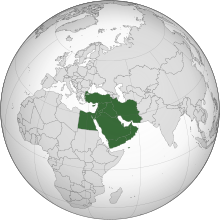Parts of this article (those related to the "Further reading" sources which were published 2001 to 2008) need to be updated. (July 2018) |
 | |
| Statistics | |
|---|---|
| Population | 371 million[1][2] |
| GDP | |
GDP growth | 3.2% (2023 est.)[5] |
GDP per capita | |
| Unemployment | |
| Public finances | |
| 35% of GDP (2023 est.)[10] | |
| Most numbers are from the International Monetary Fund. IMF Middle East Datasets All values, unless otherwise stated, are in US dollars. | |

The economy of the Middle East is very diverse, with national economies ranging from hydrocarbon-exporting rentiers to centralized socialist economies and free-market economies. The region is best known for oil production and export, which significantly impacts the entire region through the wealth it generates and through labor utilization. In recent years, many of the countries in the region have undertaken efforts to diversify their economies.
- ^ "World Population Prospects 2022". United Nations Department of Economic and Social Affairs, Population Division. Retrieved July 17, 2022.
- ^ "World Population Prospects 2022: Demographic indicators by region, subregion and country, annually for 1950-2100" (XSLX) ("Total Population, as of 1 July (thousands)"). United Nations Department of Economic and Social Affairs, Population Division. Retrieved July 17, 2022.
- ^ "GDP (Nominal), current prices". International Monetary Fund. International Monetary Fund. Retrieved 5 November 2022.
- ^ "GDP (PPP), current prices". International Monetary Fund. International Monetary Fund. Retrieved 5 November 2022.
- ^ International Monetary Fund (2022). "Real GDP growth". IMF Data Mapper. International Monetary Fund. Retrieved 5 November 2022.
- ^ International Monetary Fund (2022). "Nominal GDP per capita". IMF Data Mapper. International Monetary Fund. Retrieved 5 November 2022.
- ^ International Monetary Fund (2022). "GDP PPP per capita". IMF Data Mapper. International Monetary Fund. Retrieved 5 November 2022.
- ^ International Monetary Fund (2022). "Inflation rate, average consumer prices". IMF Data Mapper. International Monetary Fund. Retrieved 5 November 2022.
- ^ "Unemployment, total (% of total labor force)". World Bank. Archived from the original on 2020-09-24. Retrieved 2018-02-26.
- ^ International Monetary Fund (2022). "General government gross debt". IMF Data Mapper. International Monetary Fund. Retrieved 5 November 2022.